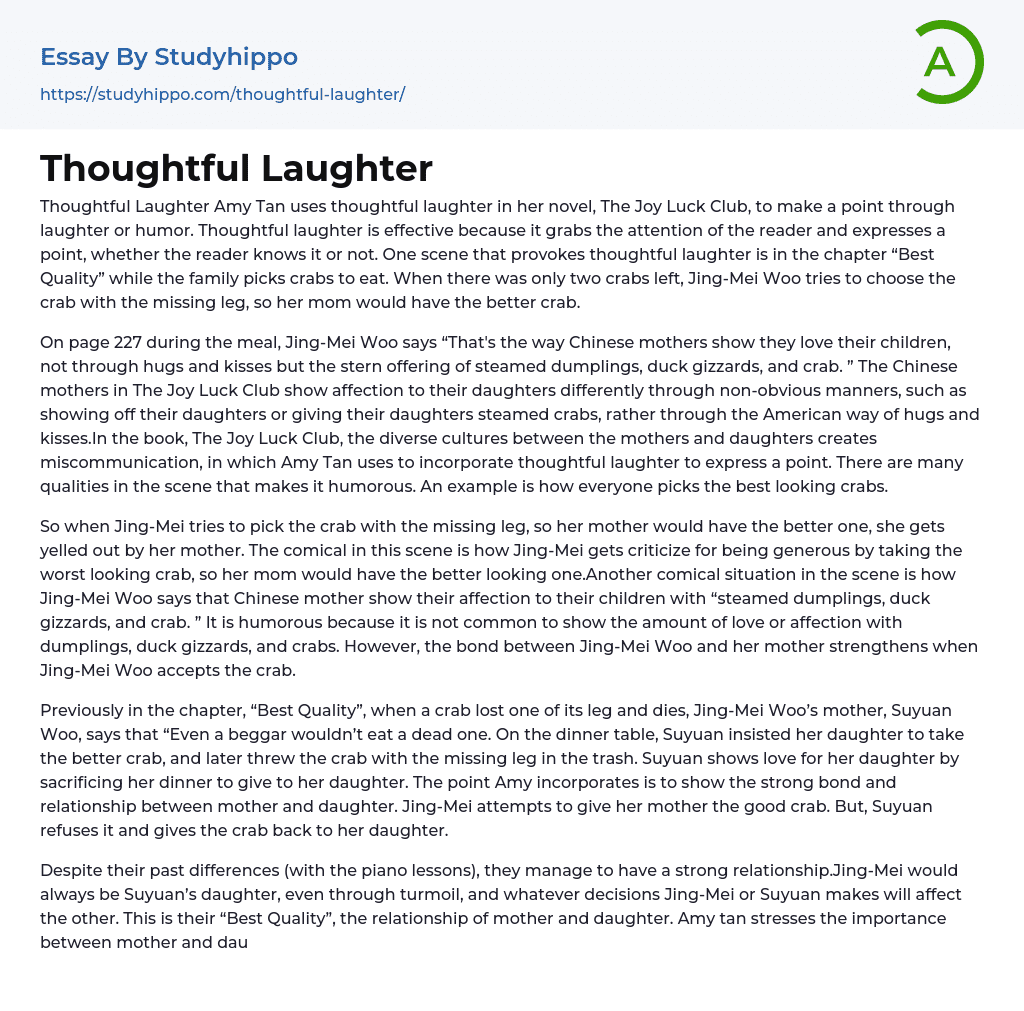Amy Tan employs the device of thoughtful laughter in The Joy Luck Club to convey a message through humor. By using this technique, Tan effectively captures the reader's attention and communicates an idea, whether it's explicit or not. A prime example of this can be seen in the "Best Quality" chapter where the family is selecting crabs to eat. In the midst of this, Jing-Mei Woo attempts to select the crab with a missing leg so that her mother can enjoy the better crab.
According to Jing-Mei Woo in The Joy Luck Club, Chinese mothers express their love for their children not by hugging or kissing them, but through actions like offering steamed dumplings, duck gizzards, and crab during meals, which may seem stern. This depicts a difference in the ways Chinese and American mothers show affection to their daughters. The book explores how mis
...communication arises between the diverse cultures of the mothers and daughters, which author Amy Tan skillfully incorporates humorous moments to convey poignant messages. Within this scene, one humorous element is the competition among everyone to choose the best looking crabs.
During the crab picking scene, Jing-Mei's attempt to be generous by choosing the crab with a missing leg for her mother is met with anger. The situation is comical as Jing-Mei is criticized for her kind gesture. Additionally, Jing-Mei's mention of how Chinese mothers express their affection through food such as steamed dumplings, duck gizzards, and crab adds to the humor as it is not typical to associate these foods with expressions of love. However, their bond becomes stronger when Jing-Mei accepts the crab.
In the chapter "Best Quality", Suyuan Woo expresse
her perspective when a crab loses a leg and dies, stating that "Even a beggar wouldn't eat a dead one." During dinner, Suyuan presents her daughter Jing-Mei with the better crab, discarding the crab with the missing leg. Suyuan's actions demonstrate her love for her daughter as she sacrifices her own meal for her daughter's benefit. The author, Amy, illustrates the powerful bond between mother and daughter through this event. Although Jing-Mei tries to offer her mother the better crab, Suyuan insists on giving it back to her daughter.
Despite their previous conflicts over piano lessons, Jing-Mei and Suyuan maintain a strong relationship. Regardless of any turmoil, they will always be mother and daughter, and each other's decisions affect the other. This is their best quality - the bond between mother and daughter. Amy Tan highlights the significance of this relationship because mothers want what is best for their daughters, having experienced their own struggles during young adulthood.
Amy Tan emphasizes the significance of the mother-daughter relationship through the use of considerate humor. However, the cultural disconnect between mothers and daughters hinders effective communication. Mothers set unattainable ambitions for their daughters, causing them to rebel and disregard their Chinese heritage during adolescence. Suyuan employs expectations as a way to show love for her daughter and guarantee a successful and prosperous life, unlike her own experiences in China.
Despite initial tension that leads to Jing-Mei snapping at her mother, as the novel progresses, the daughters mature and become more familiar with their mothers, leading them to slowly become like them. Jing-Mei initially tries to express her individuality from her mother but ultimately realizes their similarities when she meets
her half-sisters. As Jing-Mei reflects on this, she notes that they all share their mother's eyes and mouth, fulfilling her long-held wish for similarity.
Unfortunately, as there is no text provided within the , I am not able toand unify the text below. Please provide the necessary text for me to complete the task.
- Adolescence essays
- Childhood essays
- Growth Mindset essays
- Individual essays
- Infant essays
- Is Google Making Us Stupid essays
- Aldous Huxley essays
- Alice Walker essays
- Amy tan essays
- Anne Bradstreet essays
- Anton Chekhov essays
- Arthur Miller essays
- Augustine essays
- Bertolt Brecht essays
- Booker T Washington essays
- Carol ann duffy essays
- Charles Dickens essays
- Charlotte Perkins Gilman essays
- Chinua Achebe essays
- Christina Rossetti essays
- Consider The Lobster essays
- Edgar Allan Poe essays
- Elizabeth Bishop essays
- Emily Dickinson essays
- Ernest Hemingway essays
- F. Scott Fitzgerald essays
- George Orwell essays
- Harper Lee essays
- Homer essays
- James Baldwin essays
- Jane Austen essays
- John Donne essays
- John Steinbeck essays
- Kate Chopin essays
- Kurt Vonnegut essays
- Langston Hughes essays
- Leonardo Da Vinci essays
- Mark Twain essays
- Mary Shelley essays
- Maya Angelou essays
- Nathaniel Hawthorne essays
- Oscar Wilde essays
- Percy Bysshe Shelley essays
- Peter Skrzynecki essays
- Phillis Wheatley essays
- Poets essays
- Ralph Waldo Emerson essays
- Ray Bradbury essays
- Richard Rodriguez essays
- Robert Browning essays




